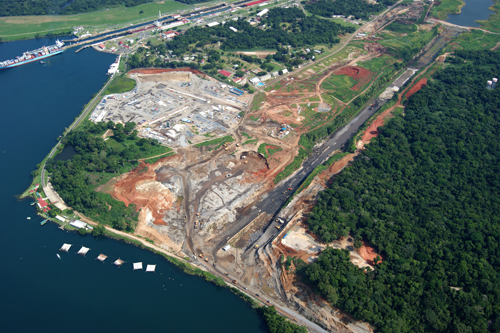
Cutting across the Isthmus of Panama, the Panama Canal is a 77.1 kilometre ship canal connecting the Atlantic Ocean, via the Caribbean Sea, to the Pacific Ocean and a hugely important conduit for international maritime trade, providing work markets with a time and cost effective crossing. Indeed the Panama Canal has had a massive transformative effect on world maritime commerce over the year, while from a local perspective it contributes some 20 percent of Panama’s total gross domestic product.
Work on the canal by the French actually began back in 1881, however a series of engineering problems and high mortality rates led to the project falling into US hands in 1904. Ten years later and the project to construct the first two-lane canal and set of locks was complete, thus enabling ships the opportunity to avoid the lengthy, often hazardous, Cape Horn route around the southernmost tip of South American or to navigate the Strait of Magellan. In 1999 control of the canal was passed on to the Panamanian government who in turn created the Panama Canal Authority (ACP), an autonomous agency tasked with managing the commercial waterway.
Since it was opened in 1914, annual traffic through the canal has risen from around 1,000 vessels per year to 14,702 in 2008. His meant that in total, to the end of 2008, more than 815,000 vessels have made use of the canal. When you take these figures into account it becomes immediately quite obvious why the focus in recent years has been on expanding the Panama Canal further still.
Led by the ACP, the Panama Canal Expansion Program (also known as the Third Set of Locks Project) is set to double the capacity of the canal by 2015 by creating a new lane of traffic, while allowing more, larger ships to make use of its waterways. Such ships will include the new generation of super container vessels, something that will open the canal up to new routes and previously untapped markets.
The project itself will involve building two new locks, one each on the Atlantic and Pacific sides (each with three chambers with water-saving basins), excavating new channels to the said locks, widening and deepening existing channels and raising the maximum operating level of the Gatun Lake, a large artificial lake that forms a major part of the canal system.
The new locks are 30 percent larger than the existing locks. They are so large in fact that you could fit three Empire State Buildings lengthwise inside their chambers. The third set of locks open and close using double sliding steel gates, each of which weighs approximately 3,300 tonnes.
In order to ensure the sustainable use of water the lock design incorporates the use of three water saving basins per chamber. These basins allow for as much as 60 percent of the contained water to be reused in each transit. Meanwhile, away from the canal itself, the ACP continues to contribute towards extensive greenfield reforestation projects where, in order to compensate for the land reclaimed for the canal expansion, some 600 hectares of space has seen the introduction of new trees. This space is also now home to the mammals, birds and reptiles that needed to be relocated once the programme got underway.
The programme of works being undertaken ranks as Central America’s most visible expansion program and the largest project in the canal’s history. It is expected that over the next two decades cargo volumes moving through the canal will continue to grow at an average of three percent per annum, almost doubling the tonnage volume of 2005 by 2025. It is because of this projected increase in traffic that the canal authority and its partners are proceeding rapidly with an undertaking that will ultimately cost $5.25 billion.
The existing two sets of locks, which raise ships 85 feet above sea level, have so far defined the “Panamax” standard, which limits the size of container vessels to a maximum of 5,000 TEU (twenty-foot equivalent units). From 2014, deeper and wider access channels will complement new locks to the southwest of the existing Miraflores Locks on the Pacific side and east of Gatun Locks on the Atlantic side. This will enable the canal to move into the “post-Panamax” phase of its evolution and accommodate the transit of 13,000+ TEU ships.
As of April 2013, 54 percent of the total expansion project had been completed with both Atlantic and Pacific entrances among the main section of the undertaking to be ready for use. Throughout the project to date the operators gave successfully managed to keep traffic volumes undisturbed despite the huge amount of dredging equipment that has been brought it.
The work currently taking place at the Panama Canal is very much what industry experts are calling history in the making and the expansion of one of the Seven Modern Wonders of the World is sure to be game changing development for traders and consumers the world over.
Written by Will Daynes, research by Abi Abagun
DOWNLOAD
 Panama-AM-T&L-Aug13-Bro-s.pdf
Panama-AM-T&L-Aug13-Bro-s.pdf













